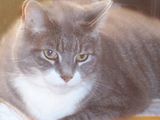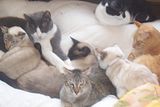IBD is actually a group of gastrointestinal disorders, usually chronic in nature, which are characterized by an increase in the number of inflammatory cells found in the lining of the stomach or intestinal tract. These changes can affect the function of the organ involved. The causes of IBD are variable, and often no single cause can be identified in a given patient. The symptoms include chronic vomiting, diarrhea, or both, and in some cases, weight loss and change in appetite. Some patients may defecate outside their litter box, especially if diarrhea is present. The symptoms may be cyclical in nature, with the cat appearing to be normal at times. It is not unusual for these patients to be misdiagnosed as having hairballs.
A definitive diagnosis of IBD is only possible by intestinal biopsy, which is best accomplished using fibreoptic endoscopy. This technology allows veterinarians to diagnose and treat many gastrointestinal disorders more easily than in the past. The endoscope is an instrument that allows visualization of the stomach and intestinal tract through a flexible tube that is passed into either the patient's stomach or colon. The tube contains fibreoptic bundles that deliver bright light to its tip and transmit the images back into an eyepiece. Small, but adequate biopsies (about the size of this capital letter "O") can be taken using this instrument, thus avoiding surgery. The procedure is performed under a short general anesthesia with most patients able to return home the same day. Since endoscopic procedures are minimally invasive (there are no surgical wounds to heal) and short in duration, they are less traumatic to the patient and recovery time is quicker.
Once diagnosed, the disease can be controlled to prevent pain and discomfort to the cat. Treatment is also aimed at preventing possible complications of the disease, such as damage to the liver, malnutrition, ulcers, and in some cases, the future development of cancer. Many medications can be used to control IBD. These include prednisone (the treatment of choice in many cases), some antibiotics, and antiemetics (drugs that suppress vomiting). A new drug, budesonide (Entocort®) is currently being investigated for treatment of IBD in cats. Although it is a corticosteroid drug like prednisone, it is metabolized differently and may reduce the potential for long-term side effects that can be associated with corticosteroids. Once therapy is started, it is usually continued for two to three months, before attempts are made to decrease the amount of medication. In many cases, a hypoallergenic diet may be recommended to aid in control of the disease.
Any cat with unexplained vomiting or diarrhea, especially chronic and intermittent in nature, should be examined for IBD. This disease is often overlooked and is under-diagnosed, leaving many cats to live in some measure of discomfort. With fibreoptic endoscopy, diagnosis is safe and minimally invasive. Treatment will not only avoid serious future complications, but will improve the cat's quality of life.
The Winn Feline Foundation
I want to start by saying that I want to do what's right for Micah...but I need some opinions...

But I can tell that he's not feeling well.







 Reply With Quote
Reply With Quote Good luck
Good luck 
 (pronounced: Marley).
(pronounced: Marley). 




Bookmarks